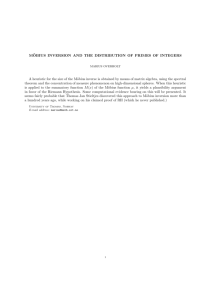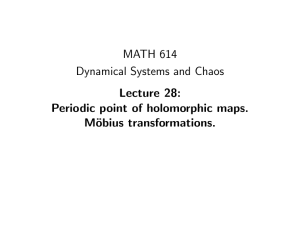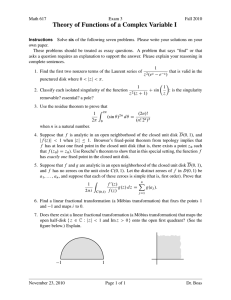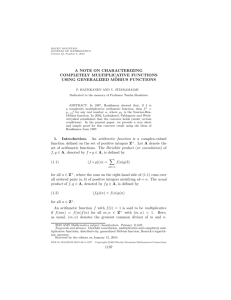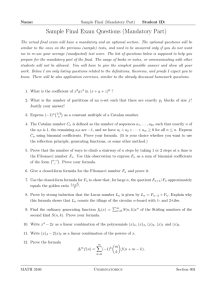Document 10822120
advertisement
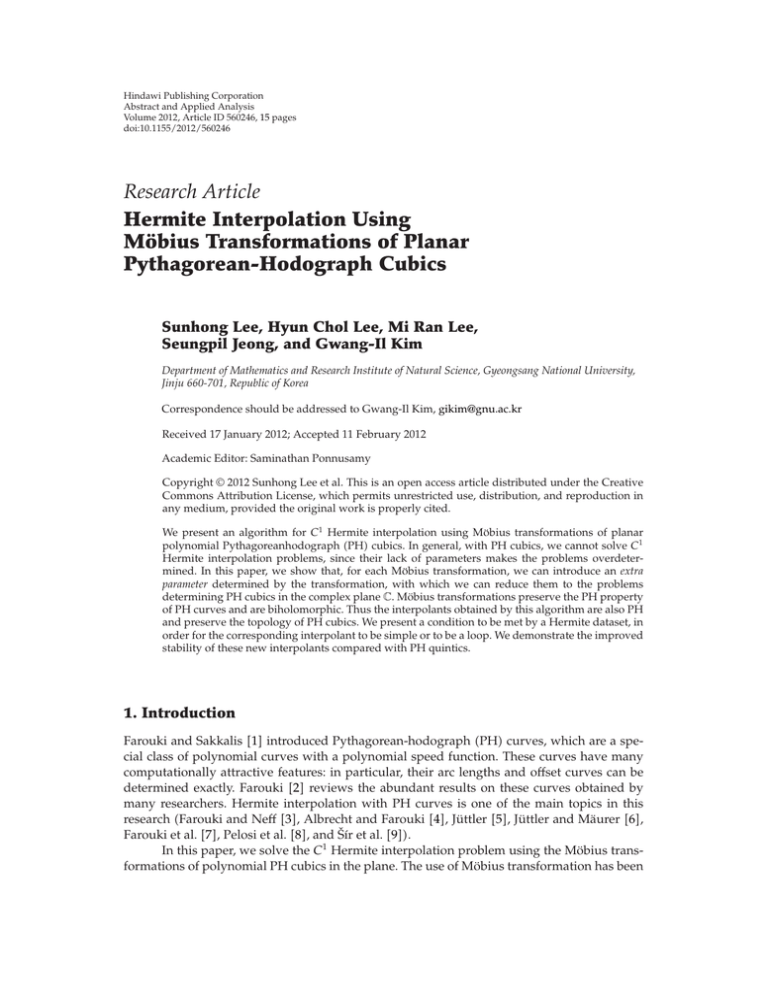
Hindawi Publishing Corporation
Abstract and Applied Analysis
Volume 2012, Article ID 560246, 15 pages
doi:10.1155/2012/560246
Research Article
Hermite Interpolation Using
Möbius Transformations of Planar
Pythagorean-Hodograph Cubics
Sunhong Lee, Hyun Chol Lee, Mi Ran Lee,
Seungpil Jeong, and Gwang-Il Kim
Department of Mathematics and Research Institute of Natural Science, Gyeongsang National University,
Jinju 660-701, Republic of Korea
Correspondence should be addressed to Gwang-Il Kim, gikim@gnu.ac.kr
Received 17 January 2012; Accepted 11 February 2012
Academic Editor: Saminathan Ponnusamy
Copyright q 2012 Sunhong Lee et al. This is an open access article distributed under the Creative
Commons Attribution License, which permits unrestricted use, distribution, and reproduction in
any medium, provided the original work is properly cited.
We present an algorithm for C1 Hermite interpolation using Möbius transformations of planar
polynomial Pythagoreanhodograph PH cubics. In general, with PH cubics, we cannot solve C1
Hermite interpolation problems, since their lack of parameters makes the problems overdetermined. In this paper, we show that, for each Möbius transformation, we can introduce an extra
parameter determined by the transformation, with which we can reduce them to the problems
determining PH cubics in the complex plane C. Möbius transformations preserve the PH property
of PH curves and are biholomorphic. Thus the interpolants obtained by this algorithm are also PH
and preserve the topology of PH cubics. We present a condition to be met by a Hermite dataset, in
order for the corresponding interpolant to be simple or to be a loop. We demonstrate the improved
stability of these new interpolants compared with PH quintics.
1. Introduction
Farouki and Sakkalis 1 introduced Pythagorean-hodograph PH curves, which are a special class of polynomial curves with a polynomial speed function. These curves have many
computationally attractive features: in particular, their arc lengths and offset curves can be
determined exactly. Farouki 2 reviews the abundant results on these curves obtained by
many researchers. Hermite interpolation with PH curves is one of the main topics in this
research Farouki and Neff 3, Albrecht and Farouki 4, Jüttler 5, Jüttler and Mäurer 6,
Farouki et al. 7, Pelosi et al. 8, and Šı́r et al. 9.
In this paper, we solve the C1 Hermite interpolation problem using the Möbius transformations of polynomial PH cubics in the plane. The use of Möbius transformation has been
2
Abstract and Applied Analysis
demonstrated in recent publications 10, 11. In 11, Bartoň et al. used a general Möbius
transformation in R3 , which is defined as a composition of an arbitrary number of inversions
with respect to spheres or planes. They showed that μ ◦ xt is a rational PH curve for any
general Möbius transformation μx1 , x2 , x3 , if xt is a polynomial PH space curve in R3 . The
preservation of PH properties under transformation is first studied by Ueda 12. They also
presented an algorithm for G1 Hermite interpolation. In this work, we use the classical Möbius
transformation, a bijective linear fractional transformation in the extended complex plane
C∞ C ∪ {∞}, that is,
Φz az b
,
cz d
1.1
for some complex numbers a, b, c, and d for which ad − bc / 0 13. Using this transformation,
we can solve the C1 Hermite interpolation problems with PH cubics. In general, with PH
cubics, we cannot solve C1 Hermite interpolation problems, since their lack of parameters
makes the problems overdetermined. But we can show that, for a C1 Hermite interpolation
problem, we are always able to obtain four interplants which are constructed by PH cubics.
The Möbius transformation makes this possible, since it permits the introduction of a new
extra parameter into the problem, which is to be reduced to a simple problem to determine
PH cubics as follows: here we adapt the complex representation method 14 to solve the C1
Hermite interpolation problem. The original problem is, for a Hermite dataset pi , pf , vi , vf ,
to find a polynomial PH curve rt and a Möbius transformation Φz, which satisfy
Φ ◦ r0 pi ,
Φ ◦ r1 pf ,
Φ ◦ r 0 vi ,
Φ ◦ r 1 vf .
1.2
Next, by an appropriate translation, rotation, and scaling of the dataset, we can arrange that
pi 0 and pf 1 and take a Möbius transformation
Φz αz
,
α − 1z 1
1.3
which fixes 0 and 1, for some nonzero complex number α. Then the inverse image of the C1
Hermite dataset under a Möbius transformation Φ makes 1.2 into
r0 0,
1
0
r tdt 1,
r 0 1
vi ,
α
r 1 αvf ,
1.4
which are suitable forms for adapting the complex representation method for details, see
Section 4. Farouki and Neff 3 already solved the C1 Hermite interpolation problem with
PH quintics. According to 1.2, this is exactly the case in which rt is a quintic and Φz is the
identity, that is, α 1. On the other hand, our work in this paper is the case just when Φz is
not the identity, that is, α / 1. At the end of this paper, we will compare our interpolants with
PH quintic ones for the same C1 Hermite dataset.
The interpolants obtained by our method are specific rational curves represented by
complex rational functions. For planar rational curves, there already exists a general theory,
which were introduced by Pottmann 15 and Fiorot and Gensane 16: they studied rational
Abstract and Applied Analysis
3
plane curves with rational offets. These curves are represented in the dual form, in which
curves are specified using line coordinates instead of point coordinates. Pottmann showed
how to design rational PH curves segments by G1 and G2 Hermite interpolations 17, 18.
However, in our work, what we need is only a suitable PH cubic and a PH-preserving transformation which is algebraically simple as possible and which can generate an extraparameter, and the latter is completely settled by the classical Möbius transformation. Moreover, the transformation is biholomorphic. Thus it preserves the topology of the preimage curve
PH cubic. Therefore, the interpolants obtained by our method should have no cusp, although cusps are a generic feature of rational PH curves. They are simple curves or else loops.
Hence, to obtain these, even avoiding the easy shortcut, there is no need to follow up the
lengthy path with a far starting point. We just use the classical Möbius transformation of PH
cubics, that is all.
The rest of this paper is organized as follows. In Sections 2 and 3, we review some
basic properties of Möbius transformations and planar PH cubics. In Section 4, we solve the
C1 Hermite interpolation problem using the Möbius transformations of planar PH cubics.
In Section 5, we present the condition on a Hermite dataset, which determine whether the
corresponding Hermite interpolant has a loop, we also compare these new interpolants with
PH quintics and show that the former have improved stability. We conclude this paper in
Section 6.
2. Möbius Transformations
A Möbius transformation Φz is a bijective linear fractional transformation in the extended
complex plane C∞ C ∪ {∞}, that is,
Φz az b
,
cz d
2.1
for some complex numbers a, b, c, and d for which ad − bc / 0 13. Then Φz is a one-to-one
correspondence on the extended complex plane C∞ with its inverse
Φ−1 z dz − b
.
−cz a
2.2
The derivative of Φz is
Φ z ad − bc
cz d2
.
2.3
For any Möbius transformations Φz and Ψz, Ψ ◦ Φz is also a Möbius transformation.
Thus the set M of all Möbius transformations forms a group under composition.
√
A rational plane curve rt xt −1yt is called a Pythagorean-hodograph PH
curve 1 if there exists a rational function σt such that
x t2 y t2 σt2 .
2.4
4
Abstract and Applied Analysis
Lemma 2.1. Let Φz be a Möbius transformation and rt be a polynomial PH curve. Then st Φ ◦ rt is a rational PH curve.
Proof. Since s t Φ rtr t, we have
|ad − bc|
s t |ad − bc| r t r t.
2
2
2
Re crt d Im crt d
|crt d|
2.5
This completes the proof.
Lemma 2.1 means that Möbius transformations preserve the PH property, which is a
special case of the result of Bartoň et al. 11.
For a polynomial PH curve rt of degree n, a Möbius transformation of rt
Φ ◦ rt art b
crt d
2.6
is a rational curve, also of degree n, with coefficients in the complex plane C. However, if we
associate the complex plane C with R2 , and express Φ ◦ rt as a rational curve with real
coefficients in R2 then the result is generally a rational PH curve of degree 2n or n. If we perform a further Möbius transformation Ψz, the rational curve Ψ ◦ Φ ◦ rt Ψ ◦ Φ ◦ rt
retains a degree of 2n or n, since Ψ ◦ Φz is a Möbius transformation.
Lemma 2.2. Let Φ ◦ rt be a Möbius transformation Φz of a polynomial curve rt, such that
Φ ◦ r0 0 and Φ ◦ r1 1. Then there exist a polynomial curve st and a Möbius transformation Ψz, such that s0 0, s1 1, and Φ ◦ rt Ψ ◦ st.
Proof. We can find a Möbius transformation Φ1 z az b for some complex constants a and
b such that a /
0 and st Φ1 ◦ rt is a polynomial curve with s0 0 and s1 1. Consequently, we can obtain the Möbius transformation Ψz Φ ◦ Φ−1
1 z such that Φ ◦ rt Ψ ◦ st.
A Möbius transformation Ψz of this sort also fixes 0 and 1.
Lemma 2.3. Let Φz be a Möbius transformation with Φ0 0 and Φ1 1. Then there exists a
nonzero complex constant α such that
Φz αz
.
α − 1z 1
2.7
If τ |α| and η argα, then Φz Φτ ◦ Φη z Φη ◦ Φτ z, where
Φτ z τz
,
τ − 1z 1
eiη z
.
eiη − 1 z 1
Φη z 2.8
Proof. Let Ψz az b/cz d be a Möbius transformation with Ψ0 0 and Ψ∞ ∞.
Then from Ψ0 0 we get b 0, and from Ψ∞ ∞ we get c 0. Thus Ψz αz, where
α a/d. Let τ |α| and η argα. Then we obtain Ψz Ψτ ◦Ψη z Ψη ◦Ψτ z, where
Ψτ z τz and Ψη z eiη z.
Abstract and Applied Analysis
5
Now let Φz be a Möbius transformation with Φ0 0 and Φ1 1. Let Sz z/z − 1, so that S0 0 and S∞ 1. Then, since S−1 ◦ Φ ◦ S0 0 and S−1 ◦ Φ ◦ S∞ ∞, we get S−1 ◦ Φ ◦ Sz Ψz, where Ψz αz for some nonzero α. Thus we obtain
Φz S ◦ Ψ ◦ S−1 z αz
.
α − 1z 1
2.9
Moreover, in the same way, we can obtain Φτ z S ◦ Ψτ ◦ S−1 z and Φη z S ◦ Ψη ◦
S−1 z, so that Φz Φτ ◦ Φη z Φη ◦ Φτ z.
Since Φ z α/α − 1z 12 , we have Φ 0 α and Φ 1 1/α.
3. Planar Pythagorean-Hodograph Cubics
√
A planar polynomial curve rt xt −1yt is a PH curve 19 if and only if there exist
polynomials ht, ut, and vt, which satisfy
x t ht ut2 − vt2 ,
y t ht2utvt.
3.1
Note that, if gcdut, vt 1, then gcdut2 − vt2 , 2utvt 1. In this paper, we will
assume that ht is monic, meaning that its leading coefficient is 1.
A polynomial curve rt is a PH curve 14 if and only if there exists a polynomial ht
and a polynomial curve wt such that
r t htwt2 .
3.2
Suppose
that the PH√
cubic rt is a line. Then the hodograph r t can be expressed as htx0 √
−1y0 , where x0 −1y0 is a nonzero point and ht is the quadratic monic polynomial
ht h0 1 − t2 h1 21 − tt h2 t2 ,
3.3
2h1 .
and h0 , h1 , and h2 are real constants such that h0 h2 /
Let rt be a PH cubic for which r t wt2 . Since wt is linear, we can write wt in
Bernstein form:
wt w0 1 − t w1 t,
3.4
where w0 and w1 are distinct complex constants. The hodograph r t can then be expressed
as
r t w20 1 − t2 w0 w1 21 − tt w21 t2 .
3.5
If we represent the PH cubic rt in the Bernstein form
rt p0 1 − t3 p1 31 − t2 t p2 31 − tt2 p3 t3 ,
3.6
6
Abstract and Applied Analysis
then we obtain
1
p1 p0 w20 ,
3
1
p2 p1 w0 w1 ,
3
1
p3 p2 w21 ,
3
3.7
where p0 can be chosen arbitrarily.
4. First-Order Hermite Interpolation
We will now solve the C1 Hermite interpolation problem using Möbius transformations of
PH cubics.
the initial and final points to be interpolated, where pi /
pf . Let vi Let pi and pf be
√
√
ri e −1θi and vf rf e −1θf , respectively, be the initial vector at pi and the final vector at pf ,
where ri > 0 and rf > 0. For this Hermite dateset pi , pf , vi , vf , we want to find planar PH
cubics rt and Möbius transformations Φz which satisfy 1.2, which are equivalent to
Φ ◦ r0 pi ,
1
Φ ◦ r tdt pf − pi ,
0
Φ ◦ r 0 vi ,
4.1
Φ ◦ r 1 vf .
By an appropriate translation, rotation, and scaling of the data-set, we can arrange that pi 0
and pf 1. Then, from Lemmas 2.2 and 2.3, we seek some nonzero constants α and PH cubics
rt, which satisfy 1.4.
4.1. Case of r t ht h0 1 − t2 h1 21 − tt h2 t2
In this case, 4.1 become
r0 0,
h0 h1 h2 3,
αh0 vi ,
h2
vf .
α
4.2
From the second and third of these equations, we can see that Hermite√interpolants rt
exist
√
if and only if θi θf mπ for some integers m. In this case, for α τe −1θi or α τe −1θi π ,
where τ is any positive number, we have
h0 vi
,
α
h2 αvf ,
h1 3 − h0 − h2 .
4.3
Consequently, we can obtain the PH cubics
rt h0 h1
h0 h1 h2 3
h0
31 − t2 t 31 − tt2 t
3
3
3
4.4
Abstract and Applied Analysis
7
and their Möbius transformations
Φ ◦ rt αrt
.
α − 1rt 1
4.5
4.2. Case of r t wt2 Where wt w0 1 − t w1 t
From 3.5 and 3.6, 4.1 become
r0 0,
w20 w0 w1 w21 3,
αw20 vi ,
w21
vf .
α
4.6
If we let
√
v
ri rf √−1θ θ /2
i
f
e
,
3
4.7
and also let a w20 /3, b w21 /3 and k w0 w1 /3, then second and third equations in 4.6
imply that k v or k −v, and so we have
ab k2 ,
a b 1 − k.
4.8
Now let
am bm 1−k
1−k−
1 k1 − 3k
,
2
1 k1 − 3k
,
2
4.9
where m 1 if k v, and m −1 if k −v. Then we have a am and b bm , or a bm and
b am . Consequently, we can obtain the four PH cubics
rm,1 t am 31 − t2 t am k31 − tt2 am k bm t3 ,
rm,2 t bm 31 − t2 t bm k31 − tt2 bm k am t3 ,
4.10
where k v or k −v. Note that rm,1 rm,2 if and only if k is −1 or 1/3. From the PH cubics
rm,j t we can obtain the Möbius transformations of the PH cubics Φm,j rm,j tm 1, −1,
and j 1, 2, where
αm,j z
Φm,j z ,
αm,j − 1 z 1
αm,1 1 vi
1 vi
, αm,2 .
3 am
3 bm
4.11
If k is nonreal, then both rm,1 t and rm,2 t are nonlinear. But if k is a real number, then −1 ≤
k ≤ 1/3 if and only if both rm,1 t and rm,2 t are linear.
We can summarize these results.
8
Abstract and Applied Analysis
Theorem 4.1. Let 0, 1, vi ri e
rf > 0.
√
−1θi
, vf rf e
√
−1θf
be a C1 Hermite data-set such that ri > 0 and
a Let v be the vector given by 4.7, and let k be v or −v. Then all C1 Hermite interpolants
using Möbius transformations of planar PH cubics rt, such that r t wt2 for some
linear curve wt, are Φm,j rm,j tm 1, −1, and j 1, 2, from 4.10 and 4.11,
where am and bm are given by 4.9.
b C1 Hermite interpolants using Möbius transformations of planar PH cubics rt, such that
r t h0 1 − t2 h1 21 − tt h2 t2 for some real number h0 , h1 , and h2 such that h0 h2 / h1 , exist if and only if θi θf mπ for some integers m. In this case, the interpolants
√
Φ ◦ rt
are given by 4.5, where rt is given by 4.3 and 4.4, where α τe −1θi or
√
α τe −1θi π for any positive number τ.
5. Best Interpolant
In this section we consider how to choose the best interpolant for a given Hermite data-set
pi 0, pf 1, vi , vf .
We will begin by presenting a condition under which the Möbius transformation of
a PH cubic Φ ◦ rt has a loop, where r t w0 1 − t w1 t2 for some distinct complex
constants w0 and w1 . Since Φz represents a one-to-one correspondence on the extended
complex plane, the condition that rt has a loop is both necessary and sufficient to establish
that Φ ◦ rt has a loop. Under the conditions r0 0 and r1 1, the PH cubic rt is given
by rt At − B3 C, where
A
w0 − w1 2
,
3
B
w0
,
w0 − w1
C
w30
.
3w0 − w1 5.1
The condition that there exist constants t1 and t2 , such that 0 ≤ t1 < t2 ≤ 1 and rt1 rt2 ,
is necessary and sufficient to establish that rt has a loop. From rt1 rt2 , we can obtain
3B2 − 3t1 t2 B t21 t1 t2 t22 0, which implies
B
3t1 t2 ±
√
√
−1t2 − t1 3
.
6
5.2
√
t2 − t1 2 3|Im B|,
5.3
This equation is equivalent to
t1 t2 2 Re B,
and hence
t1 Re B −
√
3|Im B|,
t2 Re B √
3|Im B|.
5.4
Consequently, rt has a loop if and only if B ∈ Ω1 ∪ Ω2 , see Figure 1 where
√
√
Ω1 z ∈ C0 ≤ Re z − 3 Im z < Re z 3 Im z ≤ 1 ,
√
√
Ω2 z ∈ C | 0 ≤ Re z 3 Im z < Re z − 3 Im z ≤ 1 .
5.5
Abstract and Applied Analysis
0.25
0.2
0.15
0.1
0.05
0
9
Ω1
0
0.2
0.4
0.6
0.8
1
a
0
−0.05
−0.1
−0.15
−0.2
−0.25
0.2
0.4
0.6
0.8
1
Ω2
b
Figure 1: Areas of Ω1 and Ω2 : B belongs to Ω1 ∪ Ω2 if and only if rt has a loop.
On the other hand, the PH cubic rt can be represented by
rt a31 − t2 t a k31 − tt2 a k bt3 ,
5.6
where a w20 /3, k w0 w1 /3, and b w21 /3. From k w0 w1 /3 and B w0 /w0 −w1 , we can
obtain
B2 − B 1
k
,
1 − 3k 1/k − 3
5.7
and hence
k
1
1
.
−
3 33B2 − 3B 1
5.8
Note that
√
√
1
1
−
∈
C
|
0
≤
Re
z
−
3
Im
z
<
Re
z
3
Im
z
≤
1
3 33z2 − 3z 1
√
√
1
1
−
∈
C
|
0
≤
Re
z
3
Im
z
<
Re
z
−
3
Im
z
≤
1
.
3 33z2 − 3z 1
5.9
Therefore we conclude as following.
Theorem 5.1. Suppose that Φ ◦ rt is a Möbius transformation of a planar PH cubic, such that
r0 0, r1 1, and r t w0 1 − t w1 t2 for some distinct complex constants w0 and w1
(see Figure 2). Then Φ ◦ rt0 ≤ t ≤ 1 is a simple curve if and only if w0 w1 /3 ∈
/ D, where
D
√
√
1
1
−
∈ C | 0 ≤ Re z − 3 Im z < Re z 3 Im z ≤ 1 .
3 33z2 − 3z 1
5.10
10
Abstract and Applied Analysis
2
1
D
−1.4 −1 −0.4 0
−1
−2
Figure 2: Area of D: w0 w1 /3 ∈
/ D if and only if Φ ◦ rt in Theorem 5.1 is a simple curve.
For a given Hermite data-set 0, 1, vi , vf , the term v in 4.7 belongs to D if and only if
Φ1,1 ◦ r1,1 t and Φ1,2 ◦ r1,2 t have a loop; and −v belongs to D if and only if Φ−1,1 ◦ r−1,1 t
and Φ−1,2 ◦ r−1,2 t have a loop. Note that D is a subset of the left half-plane, that is, D ⊂
{z ∈ Z : Re z < 0}. Thus we can deduce that both Φ1,1 ◦ r1,1 t and Φ1,2 ◦ r1,2 t, or both
Φ−1,1 ◦r−1,1 t and Φ−1,1 ◦r−1,2 t are simple curves. From these simple curves we can choose
a best interpolant, which is that with the least bending energy
EΦ ◦ rt Φ◦r
κ2 ds 1
κt2 Φ ◦ r tdt,
5.11
0
where κ is the curvature of Φ ◦ rt.
Example 5.2. Consider a Hermite data-set 0, 1, 2e−
√
v
√
−1π/4
, 2e−
√
−1π/8
. Then the vector v becomes
ri rf √−1θ θ /2 2 −√−13π/16
i
f
e
e
.
3
3
5.12
Thus v ∈
/ D and −v ∈ D, which implies that Φ1,1 ◦ r1,1 t and Φ1,2 ◦ r1,2 t are simple but
Φ−1,1 ◦ r−1,1 t and Φ−1,2 ◦ r−1,2 t each have a loop. See Figure 3.
Example 5.3. In the case of a Hermite data-set 0, 1, e−
√
v
√
−13π/5
, e−
√
−1π/5
ri rf √−1θ θ /2 1 −√−12π/5
i
f
e
e
.
3
3
, the vector v becomes
5.13
Thus v ∈
/ D and −v ∈
/ D, which implies that Φ1,1 ◦ r1,1 t, Φ1,2 ◦ r1,2 t, Φ−1,1 ◦ r−1,1 t, and
Φ−1,2 ◦ r−1,2 t are all simple. See Figure 4.
Abstract and Applied Analysis
11
2
0.6
0.4
1
0.2
−v
−2
−1
0
v
1
2
−0.4
−0.2
0
0.2
0.4
0.6
0.8
1
1.2
1.4
−0.2
−1
−0.4
−0.6
−2
b
a
0.1
0.05
0
−0.05
−0.01
−0.15
0.2
0.4
0.6
0.8
1
c
√
√
Figure 3: For the Hermite dataset 0, 1, 2e− −1π/4 , 2e− −1π/8 , the graph on the left shows that −v ∈ D and
v∈
/ D; the central graph shows the PH cubics rt with their control polygons; the graph on the right shows
the four interpolants.
√
√
Example 5.4. Consider a family of C1 Hermite data-sets 0, 2, k1 −1, 12 −1, where k 1, 5, 10, 20. We construct C1 Hermite interpolants that satisfy these data-sets using Möbius
transformations of PH cubics, and also PH quintics, all shown in Figure 5. The Möbius transformations of the PH cubics always provide two S-shaped simple curves and two other
curves; the latter are C-shaped simple curves when k 1 or 5 and have a single loop in the
other cases. As the parametric speed of the initial Hermite condition increases, the C-shaped
interpolants change from simple curves to single loops, while the simple S-shaped interpolants retain their original shape characteristics. We also observe that, unlike the S-shaped
interpolants produced by Möbius transformations of PH cubics, the S-shaped PH quintic
interpolants may be simple like the curve labeled 4 in Figure 5, or have one or two loops
some PH quintics labeled 2 in Figure 5 are S-shaped double loops.
We observed the behavior of these interpolants as the parametric speed at the endpoints changes. As this speed increases, the arc-lengths of PH quintics increase rapidly, but
the arc-length, of Möbius transformations of PH cubics are generally less affected. In particular, the simple S-shaped interpolants, produced by Möbius transformations of PH cubics
show little change in arc-length. Table 1 shows that these latter interpolants have both lower
bending energies and shorter arc-lengths, than all the other interpolants we are considering.
If we look at Table 1 and identify the most shapely interpolants with the lowest bending
energies, we find that the best Möbius transformation of a PH cubic is always S-shaped and
12
Abstract and Applied Analysis
2
1
−v
−2
−1
0
1
2
v
−1
−2
a
0.3
0.2
0.1
−0.1
0
0.2
0.4
0.6
0.8
1
−0.2
−0.3
b
0.2
0
0.2
0.4
0.6
0.8
1
1.2
−0.2
−0.4
−0.6
−0.8
−1
c
√
√
Figure 4: For the Hermite data-set 0, 1, e− −13π/5 , e− −1π/5 , the graph on the left shows that −v ∈
/ D and
v∈
/ D; the central graph shows the PH cubics rt with their control polygons; the graph on the right shows
the four interpolants.
Abstract and Applied Analysis
0.5
1
4
1.5
2
0.5
1
2
0.5
1
1.5
4
2
0.5
4 1.5
2
3
0.6
0.4
0.2
0
−0.2
(a)′
3
1
1.5
2
(c)
2
0.5
1
3
(b)
1
4
2
0
−0.5
3
(a)
0.2
0
−0.2
−0.4
1
0.5
2
−0.25 0
−0.5
−0.75
3
1
1
0.5
0.25
1
2
0.4
0.2
−0.2 0
−0.4
−0.6
13
1
1
4
0.5
1.5
1
2
0
2
4
0.5 1 1.5 2 2.5
3
(b)′
(c)′
2
1
1
0.5
0
2
1
2
0.5
4
1
1.5
0
2
4
3
1
2
1
3
−0.5
3
(d)
(d)′
√
1
Figure
√ 5: Comparison of pairs of PH interpolants, satisfying the same C Hermite data-set 0, 2, k1 −1,
1 2 −1, when k 1, 5, 10, 20: a, b, c, and d, respectively, show the Möbius transformations of the
PH cubics MCi when k 1, 5, 10, 20; and a , b , c , and d show the correspoding PH quintics Qi .
simple. However, the merit of the PH quintic interpolants depends on the parametric speeds
at their end points. For example, in Figures 5a and 5b , the curves labeled 4 are best, while
the curves labeled 1 are best in Figures 5c and 5d . Looking closely at the PH quintic interpolants, we see that the simple S-shaped curve with the best shape when k 1 becomes less
and less acceptable as the parametric speeds at the end-points increase. But the interpolants labeled 1 in Figures 5a , 5b , 5c , and 5d exhibit the opposite behavior: initially
these curves are C-shaped loops with high bending energies when k 1; but as the parametric speed increases, they become C-shaped simple curves with lower bending energies.
When k reaches 20, it has the best shape but the greatest arc-length. This suggests that the
best-shaped interpolants, produced by Möbius transformations of PH cubics are more stable
than the corresponding PH quintics, in the sense that the former largely achieve a lower arclength and bending energy than the latter, except when the end-point speeds are significantly
asymmetric, as we see when k 20 in this example.
14
Abstract and Applied Analysis
Table 1: Comparison of arc-length and bending energy for the interpolants of Figure 5.
k1
arc-length
BE
k5
arc-length
BE
k 10
arc-length
BE
k 20
arc-length
BE
MC1
3.03
45.0
MC1
2.93
50.2
MC1
2.89
54.03
MC1
2.85
60.1
MC2
2.19
5.5
MC2
2.28
6.5
MC2
2.31
8.2
MC2
2.34
11.9
MC3
3.10
72.8
MC3
4.50
20.9
MC3
5.47
16.6
MC3
6.13
17.7
MC4
2.29
6.8
MC4
2.31
5.7
MC4
2.36
7.5
MC4
2.40
11.3
Q1
2.34
149
Q1
3.05
36.1
Q1
4.42
14.4
Q1
7.91
8.0
Q2
2.16
3106
Q2
2.40
762
Q2
3.02
345.9
Q2
5.39
136
Q3
2.34
273
Q3
3.05
47.3
Q3
4.42
19.3
Q3
7.91
10.7
Q4
2.16
5.3
Q4
2.40
10.0
Q4
3.02
36.9
Q4
5.39
97.9
6. Conclusions
Möbius transformations preserve Pythagorean-hodograph properties. For any C1 Hermite
data-set, we can generally obtain four C1 Hermite interpolants as Möbius transformations of
PH cubics. We have proved that these interpolants are always simple curves or single loops,
and that at least two of them must be simple. We have also presented the condition that an
interpolant must meet if it is to be a simple curve.
We compared the shape characteristics of C1 Hermite interpolants, produced by
Möbius transformations of PH cubics, together with their response to changes of parametric
speed at their end points, with the same data for PH quintic interpolants satisfying an identical C1 Hermite dataset: we found that interpolants produced by Möbius transformations of
PH cubics generally have lower bending energies and shorter arc-lengths than PH quintics.
One avenue for further research is to look for ways of predicting how the geometry of
Möbius transformation of PH cubics will be determined by a particular C1 Hermite data-set.
Another avenue to explore would be the application of Möbius transformations to other
interpolation problems involving PH or MPH curves, in both two and three dimensions.
In particular, we might look to complete the geometric characterization of Möbius transformation of PH cubics in C1 Hermite interpolation.
Acknowledgment
This research was supported by the Korea Science and Engineering Foundation KOSEF
Grant funded by the Korea government MEST 2009-0073488.
References
1 R. T. Farouki and T. Sakkalis, “Pythagorean hodographs,” Journal of Research and Development, vol. 34,
no. 5, pp. 736–752, 1990.
2 R. T. Farouki, Pythagorean-Hodograph Curves: Algebra and Geometry Inseparable, vol. 1 of Geometry and
Computing, Springer, Berlin, Germany, 2008.
3 R. T. Farouki and C. A. Neff, “Hermite interpolation by Pythagorean hodograph quintics,” Mathematics of Computation, vol. 64, no. 212, pp. 1589–1609, 1995.
Abstract and Applied Analysis
15
4 G. Albrecht and R. T. Farouki, “Construction of C2 Pythagorean-hodograph interpolating splines by
the homotopy method,” Advances in Computational Mathematics, vol. 5, no. 4, pp. 417–442, 1996.
5 B. Jüttler, “Hermite interpolation by Pythagorean hodograph curves of degree seven,” Mathematics of
Computation, vol. 70, no. 235, pp. 1089–1111, 2001.
6 B. Jüttler and C. Mäurer, “Cubic Pythagorean hodograph spline curves and applications to sweep
surface modeling,” Computer-Aided Design, vol. 31, pp. 73–83, 1999.
7 R. T. Farouki, M. al-Kandari, and T. Sakkalis, “Hermite interpolation by rotation-invariant spatial
Pythagorean-hodograph curves,” Advances in Computational Mathematics, vol. 17, no. 4, pp. 369–383,
2002.
8 F. Pelosi, R. T. Farouki, C. Manni, and A. Sestini, “Geometric Hermite interpolation by spatial Pythagorean-hodograph cubics,” Advances in Computational Mathematics, vol. 22, no. 4, pp. 325–352, 2005.
9 Z. Šı́r, B. Bastl, and M. Lávička, “Hermite interpolation by hypocycloids and epicycloids with rational
offsets,” Computer Aided Geometric Design, vol. 27, no. 5, pp. 405–417, 2010.
10 A. I. Kurnosenko, “Two-point G2 Hermite interpolation with spirals by inversion of hyperbola,” Computer Aided Geometric Design, vol. 27, no. 6, pp. 474–481, 2010.
11 M. Bartoň, B. Jüttler, and W. Wang, “Construction of rational curves with rational. Rotation-minimizing frames via Möbius transformations,” in Mathematical Methods for Curves and Surfaces, Lecture
Notes in Computer Science, pp. 15–25, Springer, Berlin, Germany, 2010.
12 K. Ueda, “Spherical Pythagorean-hodograph curves,” in Mathematical Methods for Curves and Surfaces,
II (Lillehammer, 1997), Innovations in Applied Mathematics, pp. 485–492, Vanderbilt University Press,
Nashville, Tenn, USA, 1998.
13 L. V. Ahlfors, Complex Analysis, International Series in Pure and Applied Mathematics, McGraw-Hill,
New York, NY, USA, Third edition, 1978.
14 R. T. Farouki, “The conformal map z → z2 of the hodograph plane,” Computer Aided Geometric Design,
vol. 11, no. 4, pp. 363–390, 1994.
15 H. Pottmann, “Rational curves and surfaces with rational offsets,” Computer Aided Geometric Design,
vol. 12, no. 2, pp. 175–192, 1995.
16 J.-C. Fiorot and Th. Gensane, “Characterizations of the set of rational parametric curves with rational
offsets,” in Curves and Surfaces in Geometric Design, P. J. Laurent, A. Le Mehaute, and L. L. Schumaker,
Eds., pp. 153–160, A K Peters, Wellesley, Mass, USA, 1994.
17 H. Pottmann, “Applications of the dual Bézier representation of rational curves and surfaces,” in
Curves and Surfaces in Geometric Design (Chamonix-Mont-Blanc, 1993), P. J. Laurent, A. Le Mehaute, and
L. L. Schumaker, Eds., pp. 377–384, A K Peters, Wellesley, Mass, USA, 1994.
18 H. Pottmann, “Curve design with rational Pythagorean-hodograph curves,” Advances in Computational Mathematics, vol. 3, no. 1-2, pp. 147–170, 1995.
19 K. K. Kubota, “Pythagorean triples in unique factorization domains,” The American Mathematical
Monthly, vol. 79, pp. 503–505, 1972.
Advances in
Operations Research
Hindawi Publishing Corporation
http://www.hindawi.com
Volume 2014
Advances in
Decision Sciences
Hindawi Publishing Corporation
http://www.hindawi.com
Volume 2014
Mathematical Problems
in Engineering
Hindawi Publishing Corporation
http://www.hindawi.com
Volume 2014
Journal of
Algebra
Hindawi Publishing Corporation
http://www.hindawi.com
Probability and Statistics
Volume 2014
The Scientific
World Journal
Hindawi Publishing Corporation
http://www.hindawi.com
Hindawi Publishing Corporation
http://www.hindawi.com
Volume 2014
International Journal of
Differential Equations
Hindawi Publishing Corporation
http://www.hindawi.com
Volume 2014
Volume 2014
Submit your manuscripts at
http://www.hindawi.com
International Journal of
Advances in
Combinatorics
Hindawi Publishing Corporation
http://www.hindawi.com
Mathematical Physics
Hindawi Publishing Corporation
http://www.hindawi.com
Volume 2014
Journal of
Complex Analysis
Hindawi Publishing Corporation
http://www.hindawi.com
Volume 2014
International
Journal of
Mathematics and
Mathematical
Sciences
Journal of
Hindawi Publishing Corporation
http://www.hindawi.com
Stochastic Analysis
Abstract and
Applied Analysis
Hindawi Publishing Corporation
http://www.hindawi.com
Hindawi Publishing Corporation
http://www.hindawi.com
International Journal of
Mathematics
Volume 2014
Volume 2014
Discrete Dynamics in
Nature and Society
Volume 2014
Volume 2014
Journal of
Journal of
Discrete Mathematics
Journal of
Volume 2014
Hindawi Publishing Corporation
http://www.hindawi.com
Applied Mathematics
Journal of
Function Spaces
Hindawi Publishing Corporation
http://www.hindawi.com
Volume 2014
Hindawi Publishing Corporation
http://www.hindawi.com
Volume 2014
Hindawi Publishing Corporation
http://www.hindawi.com
Volume 2014
Optimization
Hindawi Publishing Corporation
http://www.hindawi.com
Volume 2014
Hindawi Publishing Corporation
http://www.hindawi.com
Volume 2014
